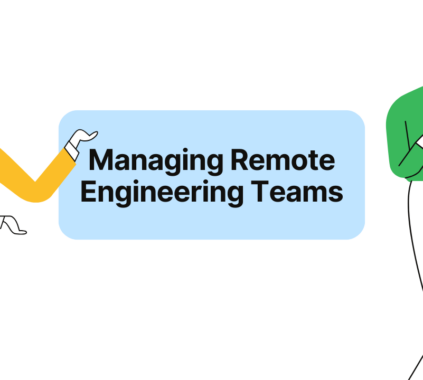Every modern business understands the pressure to innovate faster, better, and more cost-effectively. Yet, many companies still struggle to build the kind of agile, creative, and forward-thinking teams that drive innovation and bring new products to life. What if your biggest innovation roadblock isn’t budget or technology, but location?
Enter remote engineering teams. These distributed, digitally connected groups are not just a workaround for hiring shortages or pandemic constraints—they’re a powerful engine for innovation and product development.
In this blog, we dive deep into how remote engineering teams can be the catalyst for a more innovative, productive, and competitive company. From accelerating product cycles to enhancing diversity-driven creativity, let’s explore why remote-first might just be your best innovation strategy yet.
Defining Remote Engineering Teams
Remote engineering teams are groups of software developers, system architects, QA analysts, DevOps engineers, and other technical experts who collaborate from different geographical locations using digital tools. Unlike hybrid or on-site teams, these professionals work entirely remotely, often across multiple time zones.
With cloud infrastructure, project management platforms, and collaboration tools, remote engineering teams can match (or exceed) the performance of traditional teams while offering flexibility, scale, and global reach.
How Remote Engineering Teams Drive Innovation
1. Access to a Global Talent Pool
Hiring locally often limits your access to niche technical expertise. Remote engineering teams open the door to a global workforce. According to a report by McKinsey, organizations tapping into global talent pools see up to a 25% increase in innovation output.
This access allows companies to:
- Fill specialized roles faster
- Diversify their technical capabilities
- Reduce hiring costs
With platforms like GitHub, Stack Overflow, and remote job networks, you can find elite engineering talent from anywhere in the world—without the overhead of relocation.
2. Diverse Perspectives Fuel Creativity
Innovation thrives on diversity. Remote engineering teams inherently bring cultural, experiential, and cognitive diversity to the table. According to a study by Boston Consulting Group, companies with diverse leadership teams report 19% higher innovation revenues.
Remote structures allow you to:
- Include different problem-solving approaches
- Expand your market understanding
- Foster creative brainstorming sessions across borders
3. Cost Efficiency Enables Strategic Investment
Companies spend an average of $11,000 per employee per year on office space. Remote engineering teams eliminate that cost. According to Global Workplace Analytics, businesses save over $11,000 annually per half-time remote worker.
This cost efficiency allows reallocation of budgets toward:
- R&D
- Cutting-edge tools
- Upskilling and training
Remote Engineering Teams in Product Development
1. Faster Product Cycles with 24/7 Development
With distributed teams, product development becomes a 24-hour cycle. The “follow-the-sun” model ensures someone is always working on your project, significantly reducing time-to-market.
According to Muoro, remote development teams accelerate product delivery timelines by up to 30%.
2. Agile Scaling for Product Demands
As projects evolve, remote teams offer unmatched scalability. You can quickly scale up (or down) based on your development phase.
Benefits include:
- Quick onboarding of new resources
- Specialized skills on demand
- Cost-effective resourcing during testing or iteration phases
3. Better Work-Life Balance = More Productivity
Happy engineers build better products. A study by Owl Labs found that remote employees are 22% happier than on-site workers, and 91% feel more productive working remotely.
Remote engineering teams offer:
- Flexible schedules
- Reduced commute-related stress
- Greater autonomy
Common Challenges of Remote Engineering Teams (And How to Solve Them)
1. Communication Barriers
Remote work can cause communication breakdowns if not managed well. Misaligned priorities and unclear expectations can derail progress.
Solution: Use tools like Slack, Notion, and Loom for async updates and clear documentation. Schedule daily standups and sprint reviews to stay in sync.
2. Maintaining Culture and Cohesion
Remote teams can feel disconnected, leading to low morale or disengagement.
Solution: Build a strong remote culture with:
- Virtual team-building events
- Celebrating milestones
- Regular feedback loops
3. Time Zone Conflicts
When teams are spread across continents, scheduling can be tough.
Solution: Embrace asynchronous work. Record meetings. Use collaborative tools like Miro and Figma for transparent workflows.
Strategies to Maximize Remote Engineering Team Performance
1. Robust Communication Frameworks
A solid communication infrastructure is the backbone of remote innovation.
Key practices:
- Weekly demos and retros
- Clearly defined roles and responsibilities
- Real-time dashboards and project tracking (e.g., Jira, Trello)
2. Fostering Remote Culture
Remote culture isn’t an accident; it’s intentional.
Encourage:
- Open communication and psychological safety
- Recognition of team wins
- Leadership accessibility and empathy
3. Agile Methodologies
Agile frameworks like Scrum and Kanban enhance transparency and adaptability.
Advantages:
- Clear sprint planning
- Iterative releases
- Continuous feedback and improvement
Best Practices to Drive Innovation Remotely
- Hire engineers who thrive in autonomous settings
- Use OKRs to align team efforts with innovation goals
- Invest in learning & development: Udemy, Coursera, etc.
- Rotate team leads to avoid burnout and bring fresh perspectives
- Schedule quarterly virtual innovation hackathons
The Future of Remote Engineering Teams in Innovation
Remote engineering teams are here to stay. According to Gartner, 74% of CFOs plan to permanently shift employees to remote work post-pandemic.
Future trends include:
- AI-powered project management
- VR collaboration environments
- More companies adopting remote-first product teams
The tools and talent available make it easier than ever to build high-performing engineering squads that aren’t confined to office walls.
Remote engineering teams aren’t just an operational convenience—they’re a strategic asset. From diverse ideation to round-the-clock development, remote teams are reshaping how companies innovate and build products.
If you’re ready to accelerate your innovation pipeline, cut overhead, and access global engineering excellence, now is the time.
Join the AB ARK team and let us help you scale with world-class remote engineering teams tailored to your goals.
Let’s build the future, remotely.
Contact Us Today to learn how AB ARK can power your next breakthrough.











